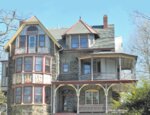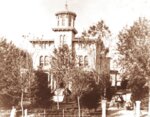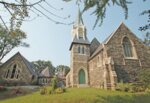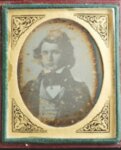The railroad executive, entrepreneur, real estate developer and philanthropist Henry Howard Houston is now remembered as the founding father of Chestnut Hill. And for good reason: he lobbied hard for the construction of the passenger rail line now known as Chestnut Hill West, which brought the people who would occupy the thousands of acres he had wisely acquired.
But long before he transformed Chestnut Hill into the leafy neighborhood we know today, Houston was honing his skills as a visionary developer in Germantown. For 23 of his most productive adult years, Houston lived in a large …
This item is available in full to subscribers.
You can also purchase this individual item for $1.50
We have recently launched a new and improved website. To continue reading, you will need to either log into your subscriber account, or purchase a new subscription.
If you are a digital subscriber with an active subscription, then you already have an account here. Just reset your password if you've not yet logged in to your account on this new site.
If you are a current print subscriber, you can set up a free website account by clicking here.
Otherwise, click here to view your options for subscribing.
Please log in to continue |






The railroad executive, entrepreneur, real estate developer and philanthropist Henry Howard Houston is now remembered as the founding father of Chestnut Hill. And for good reason: he lobbied hard for the construction of the passenger rail line now known as Chestnut Hill West, which brought the people who would occupy the thousands of acres he had wisely acquired.
But long before he transformed Chestnut Hill into the leafy neighborhood we know today, Houston was honing his skills as a visionary developer in Germantown. For 23 of his most productive adult years, Houston lived in a large Italianate house at the corner of Tulpehocken Street and Wayne Avenue. It was there that he developed the city planning and architectural styles that would later define Chestnut Hill.
By 1886, when he completed and moved into Druim Moir, his immense Scottish Baronial pile on the breezy bluffs overlooking the Wissahickon Valley, Houston was 65 years old and already one of Philadelphia's most influential real estate magnates. He would live there only a decade before his death in 1895.
Choosing Germantown
In 1856, the year that Houston stepped away from his full-time position at the Pennsylvania Railroad, he was still living in Center City and married Sallie Bonnell. They eventually had six children, two of whom died young.
Four years later, in 1860, their growing family left the crowded downtown for a rented house on the far west side of prestigious suburban Germantown, at 223 West Tulpehocken Street. Three years later, in 1863, they bought a larger house down the block that offered more gardens, nearby woods, and a respite from industrial Philadelphia but was still a short carriage ride to the many stores along Germantown Avenue and the (earlier) train line into town.
It was during these years that Houston turned his attention to a dizzying array of interrelated investments: railroads, steamships, mineral mines, coal, petroleum and of course real estate. He'd already purchased his first piece of investment land in Germantown back in 1853, and between 1865 and 1872 he bought approximately 40 more acres of land along Wayne Avenue, its side streets, and down to the nearby Monoshone Creek.
It was, like many of Houston's decisions, a prescient move. City maps in 1855 show almost no houses so far away from Germantown Avenue, but by 1862 those maps were showing side streets dotted with suburban villas, including Houston's own house. Over the succeeding decades, Houston would fill much of that open land with single and double houses.
The Houston style
As one of the most prolific developers in Northwest Philadelphia, Houston's taste in architecture flavored the character of its neighborhoods.
His preferred architect, George Watson (GW) Hewitt, got his start in the offices of John Notman, the architect who brought the Italianate style to America. Later, Hewitt worked in partnership with various other architects, including the maverick Frank Furness, and together they designed the triumphant main building for the Pennsylvania Academy of Fine Arts.
Houston commissioned the pair to create Germantown's Saint Peter's Episcopal Church – likely because of Hewitt’s association with Notman's firm, which had designed a number of important Episcopal churches around Philadelphia. In Houston's eyes, Episcopal churches attracted the "right" sort of neighbors, making them critical infrastructure for prestigious suburban neighborhoods.
This new church, now the campus of the Waldorf School, was built for the Rev. Theodore S. Rumsey, whose former Christ Church congregation just two blocks east had become entangled in the complicated ecclesiastical politics of the growing Anglo-Catholic movement. Houston donated land and funds for the Wayne Avenue project. Likely most of the handsome new church complex was designed by Hewitt, but the particularly bombastic elements on the tower suggest the hand of Furness.
Houston remained loyal to Saint Peter's throughout his life, including serving as Rector's Warden until his death, despite his later move to Chestnut Hill and the creation of Saint Martin's-in-the-Fields, which has been closely associated with his descendants ever since.
Hewitt, who formed his own firm in 1875 and ran it with his younger brother until 1907 as GW & WD Hewitt, did some good work but never reached the design genius he did when he worked with Furness.
A vision, and a long game
Houston’s houses in West Germantown included both double houses and larger single-family villas – and were the start of a career-long belief in a mix of housing sizes that he would also bring to Chestnut Hill.
While earlier houses in Germantown had been mostly built by carpenters or contractors, Houston's presented a new paradigm: architect-designed houses that were either commissioned by a client or built on speculation for renting or eventual sale. It was a pattern that Houston and his descendants have continued ever since.
For their designs, Hewitt chose the "Queen Anne" style, which came from England and featured a mixture of Tudor, Georgian, and American Shingle Style features. The villas along Wayne Avenue are similar to the series of houses Houston built around the same time along Seminole Street in Chestnut Hill, the most famous of which is the Saveur House. While they were all in the same style, each house offered a varied assortment of architectural elements.
The double houses on the 5900 block of Wayne Avenue (between Harvey and Rittenhouse streets) were also designed by Hewitt, and are very similar to the series of houses Houston clustered near Saint Martin's train station along Pocono and adjacent streets in Chestnut Hill.
Today, most of the houses on that block of Wayne Avenue have had their third stories removed, a curious record of Sam Houston, the son who took over management of Houston’s estate. He likely made that decision to save on real estate taxes around the Second World War. Sadly, he did the same to his father's Druim Moir, which explains its oddly truncated roofline. In the middle of that block of truncated houses on Wayne Avenue, however, remains one pair of houses that retain their original appearance.
Mixed in with these building types were a few houses designed in the High Victorian "Scottish Baronial" style, which became popular with the publication of Sir Walter Scott novels earlier in that century. The house at 6015 Wayne Avenue, built in 1887 for financier Henry Lister Townsend, might be considered a smaller sibling to Houston's own Druim Moir, which was being built at around that time.
As many of these houses were being built in the 1880s, the railway line now known as Chestnut Hill West was cut through Houston's own land in Germantown. Houston likely had a hand in placing the station at the end of Tulpehocken Street, just a block from his own house.
An enduring legacy
By the time Houson died in 1895, city maps show he still owned considerable amounts of open land on the west side of Germantown as well as "depots" (storage buildings built on railway sidings) near the Chelten Station for both coal and lumber. Before the advent of trucks, railways were the primary means of transporting such necessities.
Eventually, as the family turned its focus to Chestnut Hill and Roxborough, the Germantown holdings would be either developed, sold or donated to create parts of the Wissahickon Park.
Today, Henry Howard Houston’s Germantown years are commemorated by a handsome bronze statue of him that stands near the intersection of Harvey Street and Lincoln Drive, just blocks from his Germantown houses and a series of elaborate Adirondack-style gardens called the Houston Ramble, which now are long gone.
Designed by the prolific Scottish-American sculptor J. Massey Rhind, Houston’s sculpture was installed in 1900 by the Fairmount Park Commission to honor the family's donation of nearby land.
That statue – and the many houses he created – stand as a stubborn testament to Houston's Germantown legacy, and the vision and influence he cultivated long before turning his attention to Chestnut Hill.